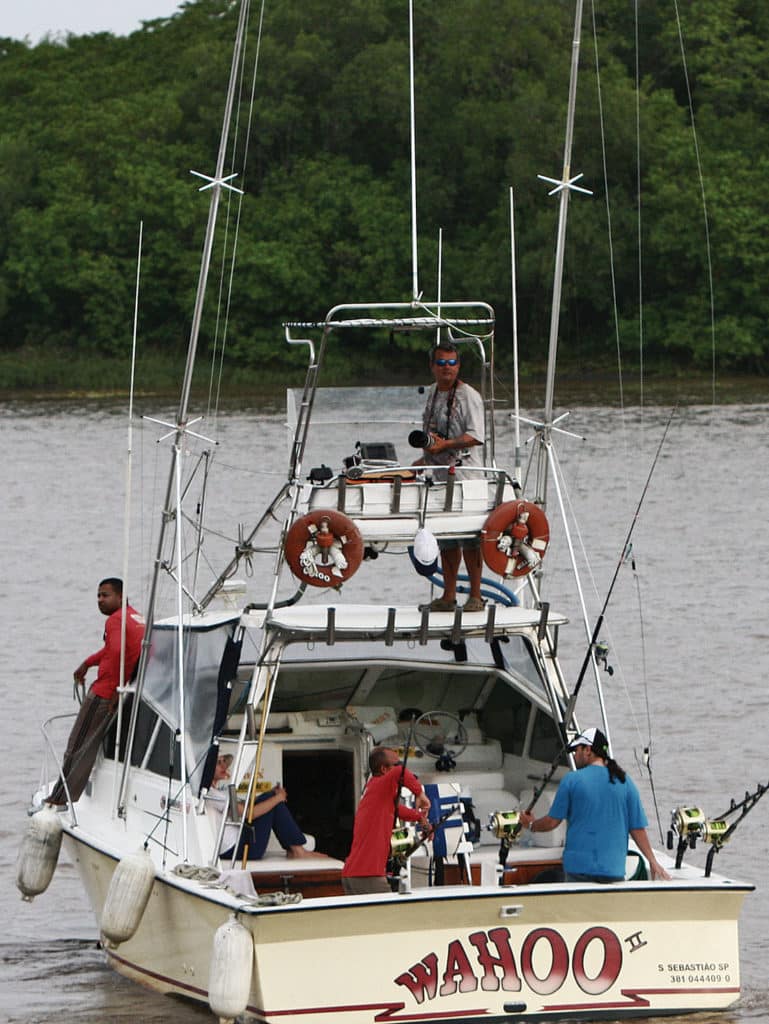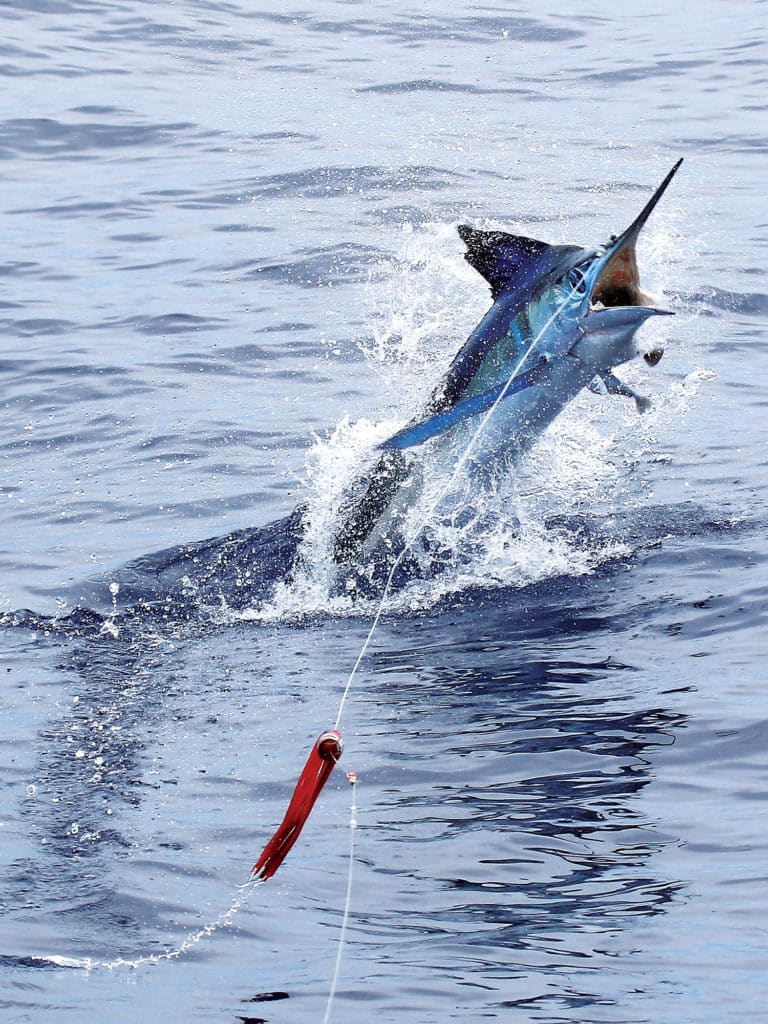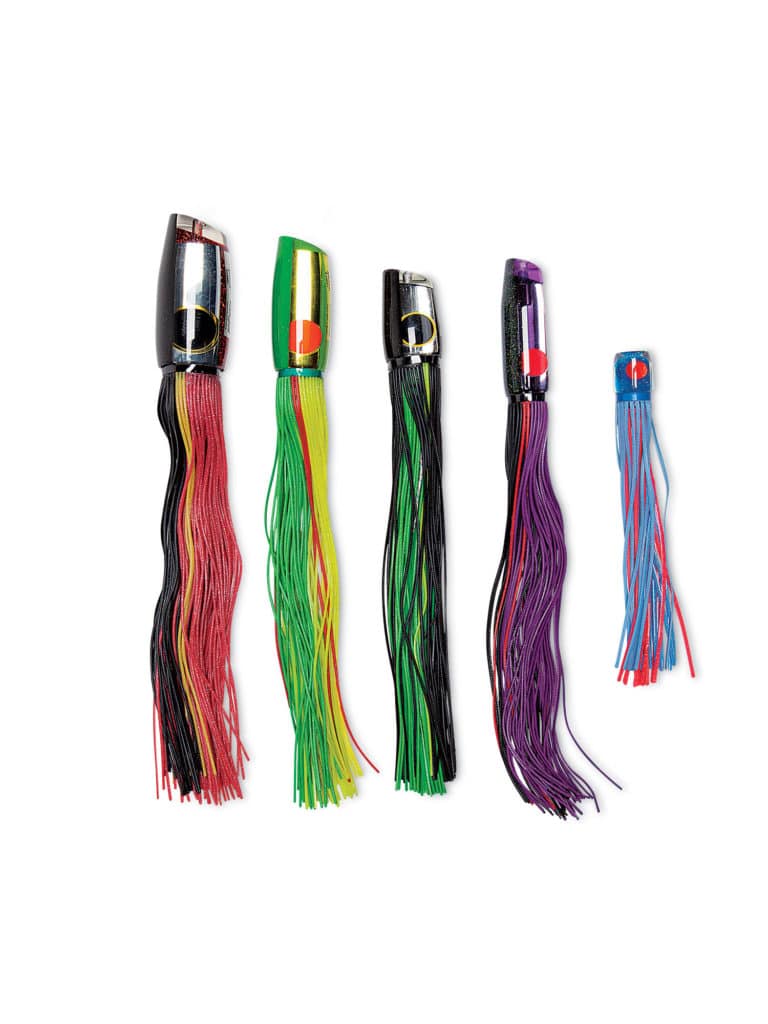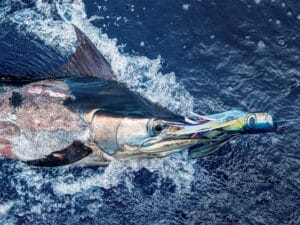
“There’s a fish on the red Naja!” Capt. Antonio Amaral screams from the bridge at the exact same moment a big blue marlin crashes the lure from the inside out. The attack leaves a gigantic hole in the water where Amaral’s custom lure once splashed aggressively on the surface. The violent bite wasn’t on just any lure, it was on one of his favorites — one he built himself.
Find a lure maker and their love for the craft will be evident within their first few words: head shapes and styles, colors, inserts and skirts — every lure builder has their own style and signature approach to building what they believe to be the perfect lure. But for Amaral, also known by his nickname, “Tuba,” lure making is more than just a love of the craft — some could even classify it as an obsession. I ask about the inspiration for his lures. He replies: “It is something that comes from within and not something I can easily explain. I’ve always had a passion for lure fishing. Building my own lures allows me to have them run exactly how I want.”

Testing Grounds
Amaral and his charter boat, Wahoo, see more than their fair share of blues behind the boat in his home waters off Canavieiras, Brazil, which is often passed over as a top blue marlin location. The peak of the blue marlin season on the Royal Charlotte Bank begins in mid-September and runs through late April or early May, but he says you can catch a blue marlin year-round. Recalling some of his great seasons, he says: “The best year I had here was the 2011-2012 season. We released nearly 100 blues, tagging 72 of them, and we also released two granders.” The blue marlin there average between 400 and 500 pounds, and the white marlin regularly exceed 120 pounds. Add a healthy mix of other pelagics and Amaral might be fishing one of the most overlooked fisheries in the entire world.

Prior to making his own custom lures, Amaral used the normal arsenal found in the spread of top sport-fishing boats around the world. They worked, but they were often difficult to get in Brazil or were simply too expensive. He also thought some of the lures didn’t perform as well in the rough conditions found in his home waters compared to hot spots like Hawaii, where the lures were developed to fish in calmer conditions. “I have always been a perfectionist,” says Amaral. “I like things done my way, and I think it was just a matter of time for me to make my own lures to do exactly what I wanted them to do.
“The Marlin Magic Big Dog, Joe Yee’s Super Plunger, the Pakula Sprocket, the Aloha Smash Bait, and the Hydra and Dracula from Legend Lures are some of my favorites,” Amaral continues. “Many of those lures were really striking, and I was inspired by them to develop my own designs. My first two lures, Mamba and Naja, took some of the features I liked in each of those lures and incorporated them into the design.” And building an effective lure is never an easy process. It requires constant tweaking and adapting to find the action desired, and that can vary depending on sea conditions and even the boat that’s pulling them.

Trial and Error
“The action of my lures is exactly what I consider perfect on board my boat for the sea conditions found in Brazil,” Amaral says. He starts the process with a block of resin on a lathe and uses different tools to form the desired head shape. Because he runs nearly 200 trips a year as part of his Bahia Pesca charter operation, he has plenty of opportunities to test a prototype in different conditions. “It’s very easy for me to make changes to the head weight and face angles until I get the performance that suits me,” he explains. “Sometimes a prototype runs well the first time, but some demand many corrections.” He runs each lure at various speeds and distances behind the boat while watching how each lure performs in the water. To get a better view from underwater, Amaral uses a trolling-camera system that allows him to see how well each lure tracks and what kind of action it has in the water. He knows he’s developed an instant winner when he sees a blue marlin crash one of his prototypes.

“When I made the Mamba, I had five versions with different face angles ranging between 12 and 20 degrees,” he says. “Both the Naja and the Diamondback had good action, but they required more ballast to swim better.” Amaral currently has nine different lure models and is working on a 10th, his first jetted lure. He continually improves on each model if he thinks it could perform better. He says the new version of his Diamondback lure has three times the ballast of the original version and is quickly becoming a popular lure for captains around the world. “It has a small head that makes incredible splashes on surface, and because it has a lot of ballast, it is a really good lure for all sea conditions,” explains Amaral.

A Unique Skirt
But the head shapes of his lures are only half of the equation when building a lure, so Amaral uses an uncommon hula skirt that gives him complete control over the customization of his lures. “They are inspired by the old Trawlite and Murray Brothers skirts,” he explains. Similar in shape and feel to a stiff spaghetti noodle, the skirts come in sheets and allow him to use different colors for the top of the skirt, the midbody stripe and bottom as well as the underskirt. In a relatively simple process, Amaral cuts the desired number of strands from the sheet and glues them directly to the head to make the desired pattern. An added benefit to these skirts is that they won’t tangle. And should one become shortened from a toothy critter, the damaged strands can be individually removed and replaced instead of having to replace the entire skirt as you would with an octopus-style skirt.

“The first skirts I bought were made in China, but freight and taxes were just too expensive to make it worthwhile,” Amaral adds. “I talked with a friend who works with thermoplastics to see if he could try to produce them. After some time, we got a very good result, and we can now control how soft or hard the skirt material is from batch to batch.
I can also create any color I want.” The skirts on his lures are always left a little longer than usual, so each customer can adjust them to fit their hook-sets as well as modify the skirts to get the desired action. “The shorter the skirt on the lure, the more aggressive and erratic it will swim. Leave it long for a more stable swimming pattern,” he says.

Color Perfect
Amaral adds, “You must agree that my lures have a unique appearance because of skirts matching the color of the head!” I couldn’t agree more as I held one of Amaral’s custom lures in my hand while admiring his craftsmanship and attention to detail. The lures vary in color depending on his goal. Sometimes he attempts to imitate a baitfish pattern, like a flying fish or mahimahi, or he aims to create something with high contrast that can arouse the interest of a fish. The opportunities are limitless — he can customize the color on the back, in the insert, the eye and rim on the lure head, and then create a corresponding skirt combination with different colors for the top, stripe, belly and the inner skirt. Another defining characteristic of an Amaral lure is the use of mirrors on the insert within the head. About 90 percent of his lures have mirrors, and he believes the reflective nature of a mirror entices more marlin toward his lures.
Knowing all captains have different theories and preferences when it comes to lure colors, I pick his mind to find out what combinations are typically found in his spread. “The colors I pull are black-and-green, purple-and-pink, black-and-red, blue-and-pink, and blaze orange. But my first choice is red, and I always make sure to have one in the water. It’s not that I believe red attracts more marlin, but it is a color that I can look at the spread at any time and see where it is and how it is working,” says Amaral.

A Labor of Love
A one-man operation, Amaral builds every one of his lures from start to finish, designing them to catch fish, not just look pretty.
“I put a lot of love into my lures,” Amaral says with a smile on his face. Perhaps if marlin knew about Amaral’s lure obsession and drive for perfection, they’d give his lures a second or third look — but maybe they already do, given the great success he’s had pulling his own lures.
To see more of Amaral’s lures, visit his Facebook page.







